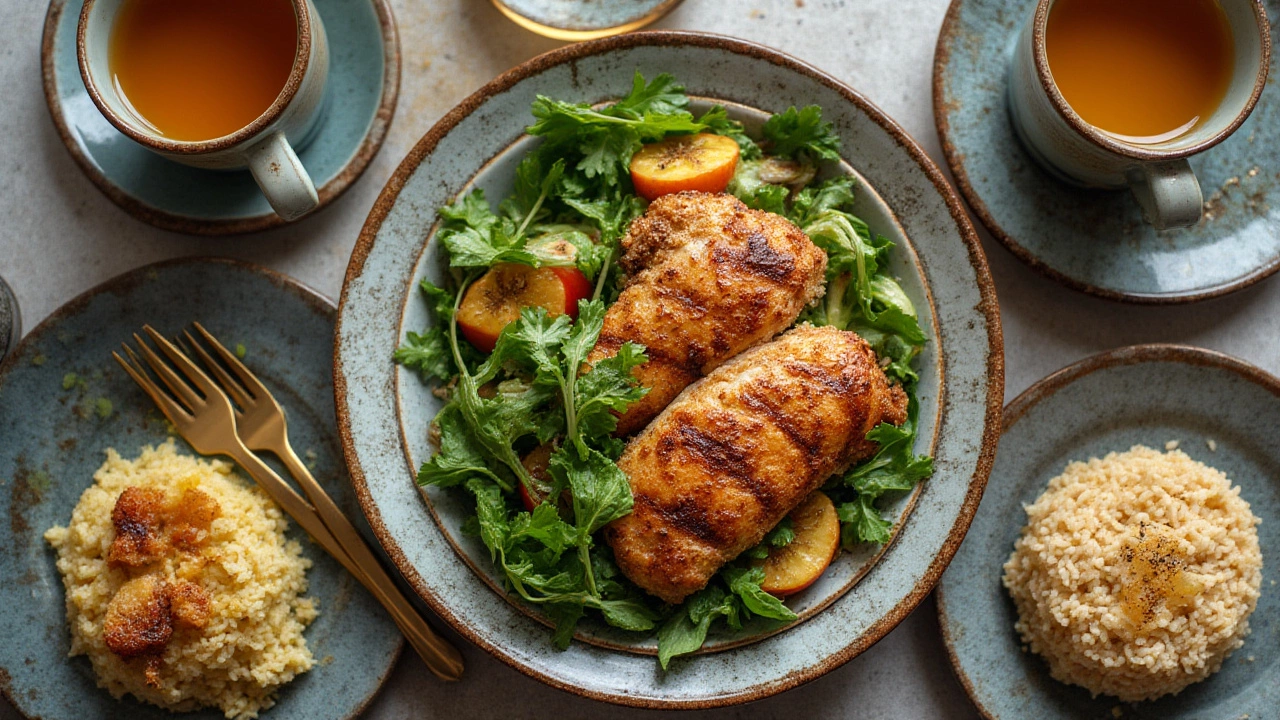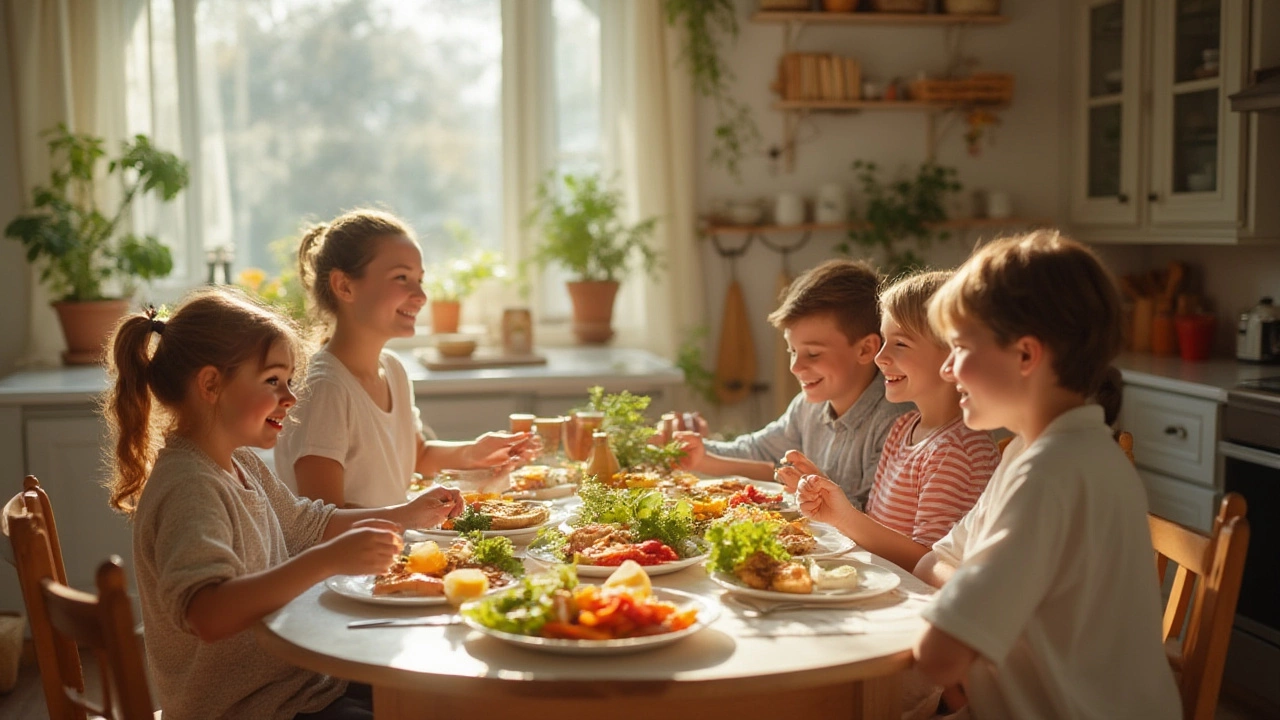If you spent any time scrolling through Instagram or TikTok lately, you’ve probably seen endless posts showing “the ultimate plate”—perfectly arranged veggies, pretty salmon fillets, maybe some wild rice, all glowing under a filter. Is that really what the healthiest most balanced meal looks like? Turns out, the answer is less about how it looks and more about what it actually does for your body and mind. My daughter Ainsley, a notoriously picky eater, once declared a meal with broccoli and quinoa “yucky”—until I tweaked it into something she loved, and suddenly, even our family dog was sniffing around at dinner. The thing is, making a truly balanced healthy meal isn’t just for fitness models or health coaches. Anyone—busy parents, students, retirees—can pull this off. The trick is finding a combination that fuels you, feels doable, and yes, actually tastes good.
What Makes a Meal Truly Balanced?
What comes to mind when you hear “balanced meal”? Kale salads every night? That’s a trap lots of us fall into—thinking balance means forever skipping dessert, or that chocolate is off limits. But look at research from Harvard’s School of Public Health: Their model, called the Healthy Eating Plate, is all about proportions. It shows half your plate should be vegetables and fruits (heavy on veggies), a quarter whole grains, and the last quarter protein—preferably lean options like beans, fish, or poultry. They also call out the importance of healthy oils and water. Notice what’s not featured front-and-center? Processed foods. You know, those freezer aisle pizzas and instant noodles we pretend we don’t eat (guilty here!).
Now, balance also means hitting the right mix of macronutrients—protein, carbs, and fats—without obsessing over exact grams. Your body needs these in smart ratios for steady energy and muscle repair, and to keep cravings at bay. For protein, think fish, chicken, tofu, eggs, or legumes. Carbs? Go for brown rice, whole grain pasta, or sweet potatoes instead of fast-acting “white” versions. Then there’s fat, which scares some people off. But olive oil, nuts, avocado—these actually help the body absorb vitamins and support brain health. Swapping out a creamy dressing for olive oil vinaigrette was a game-changer for my own lunches—I still get flavor, with zero post-lunch sluggishness.
Portion size often gets overlooked. A truly balanced meal fits your energy needs. Olympic swimmers chow down 10,000 calories a day, but the average woman (around my age, with a pretty standard day) needs 1,800–2,200. Sizing your meal right helps everything fall into place—no midafternoon crash, no late-night fridge raids. Here’s a quick cheat sheet I taped to my own fridge:
- Half your plate: colorful veggies + fruit
- Quarter: whole grains or starchy veggies
- Quarter: lean protein
- Add: small serving of healthy fat (think olive oil or nuts)
- Finish: glass of water (not juice or soda!)
The World Health Organization even published data showing this style of eating cuts the risk for heart disease, stroke, diabetes, and certain cancers by up to 30%. That’s a massive payoff for a few simple upgrades at dinner time.

Breaking Down the Building Blocks: Key Ingredients for Every Meal
Stacking your plate for health isn’t only about what you eat—it’s about how it all fits together, because your food choices interact. Let’s walk through the main building blocks that make up a balanced meal. And no, you don’t have to eat plain chicken and steamed broccoli every night.
Protein: The Key Player - Protein isn’t just for athletes. Your muscles and even your immune system need regular protein to function. Animal sources—like fish, chicken, turkey, yogurt, eggs—are classic, but plant sources like lentils, chickpeas, and tofu also do a great job. Mixing it up keeps flavors fresh; tonight might be salmon, tomorrow black bean tacos.
Carbohydrates: The Right Kind Matters - The days of running from carbs are over. The trick is choosing complex carbohydrates—brown rice, quinoa, barley, whole grain bread. These give you long-lasting energy and curb blood sugar spikes. When I swapped out my daughter’s regular spaghetti for whole wheat, she barely noticed, and she stayed fuller longer.
Healthy Fats: Don’t Fear the Oil - Kids, especially, need fats for their developing brains. But it’s not just them—adults benefit from the satiating, vitamin-boosting power of healthy fats. Avocado toast isn’t just an Instagram craze; it’s a brilliant way to add monounsaturated fats while keeping taste high. Nuts, seeds, and even a small square of dark chocolate have their place here.
Fiber: The Unsung Hero - Most people barely hit 16g of fiber a day, way below the recommended 25–30g for women and 38g for men (according to the American Heart Association). Fiber in foods like beans, oats, berries, and greens helps gut health, lowers cholesterol, and keeps you regular. High fiber meals led to a visible drop in crankiness and tummy troubles at our house—seriously, it’s like magic.
Vitamins and Minerals: Don’t Forget the Extras - Color matters! Orange carrots mean vitamin A, dark green kale means loads of K, red bell peppers offer a wallop of C. Mix and match colors and you’re hitting a range of key nutrients without even trying. Fresh or frozen is fine—frozen veg is often picked at peak ripeness and sometimes has more nutrients than “fresh” sitting on store shelves for a week.
Here’s a handy table summarizing some superstar building blocks:
| Food | Key Nutrient | Health Benefit |
|---|---|---|
| Spinach | Iron, Vitamin K | Supports blood, bones |
| Salmon | Omega-3s, Protein | Good for heart & brain |
| Black Beans | Fiber, Protein | Digestive & muscle health |
| Sweet Potato | Vitamin A, Complex Carb | Eye health, energy |
| Greek Yogurt | Protein, Calcium | Bone strength, gut health |
Want a quick rule? If every meal in your week contains two colors of veg, some protein, and something high in fiber, you’re gold. Variety is what unlocks nutrition; think stir fry on Monday, loaded salad on Tuesday, baked chicken with roasted root veggies on Wednesday, and veggie chili on Thursday. Batch-cooking a grain like quinoa or brown rice at the start of the week makes mixing and matching super simple.

Everyday Tips and Real-World Tricks to Keep Meals Balanced
Eating balanced in real life rarely looks like a perfect Pinterest board. The good news: you don't need perfection, just consistency and a game plan. Here’s what works, especially in a busy household like ours, where trusted hacks often save dinner time.
Cook Extra for Mix-and-Match Meals – If I’m roasting veggies for dinner, I’ll make double so there’s leftovers for omelets, wraps, or grain bowls the next day. It saves time and avoids the “nothing healthy to eat” excuse. Bonus: roasted broccoli tastes amazing cold as a snack.
Plan Ahead, Not Rigidly – Meal planning doesn’t mean mapping out every bite. Pick two or three proteins, a couple whole grains, and several veggies at the store. Later, combine them based on what everyone wants. You could turn chicken, carrots, and brown rice into a stir fry, a soup, or a salad bowl. Flexibility = less waste and more satisfaction.
Smart Swaps for Healthier Plates – Use Greek yogurt instead of sour cream or mayo. Switch to 100% whole wheat bread and tortillas. Trade sugary cereal for oatmeal plus fruit. Choose salsa or pesto for flavor before resorting to cheese or creamy sauces. These keep meals interesting without piling on empty calories.
Portion Out in Advance – Bigger plates trick your brain. I use a smaller salad plate for meals, and it naturally encourages more vegetable and moderate protein portions. When snacks beckon, divvy them up (hello, single-serving hummus) to avoid grazing through the whole bag.
Get the Family Involved – My daughter Ainsley loves picking a “new veggie of the week” at the store and helps sprinkle herbs or arrange things on the plate, which means she’s much more likely to actually try new foods. Turns out, people of all ages have more interest in meals they helped create.
Drink Smart – The so-called healthiest meal can go sideways fast with a giant soda or juice. Water or sparkling water is best. Unsweetened herbal tea works if you miss flavor. Sometimes, a squeeze of lemon or frozen berry tossed into a drink tricks your taste buds into believing plain water is more exciting.
Eating out? Most restaurants will swap fries for salad or sub brown rice for white if you ask. Check the description for words like “grilled,” “baked,” or “steamed” instead of “fried” or “smothered.” Add a veggie side, and that burger meal levels up instantly.
Here’s an example of a week of real-life, balanced dinners anyone can manage:
- Monday: Grilled chicken, brown rice, sautéed spinach with garlic
- Tuesday: Tofu stir fry, snap peas, peppers, soba noodles
- Wednesday: Baked salmon, roasted sweet potato, steamed broccoli
- Thursday: Turkey chili, mixed beans, corn & diced tomatoes
- Friday: Lentil pasta, marinara sauce, green salad with olives
Eating well isn’t about expensive superfoods. Frozen veg are just as nutritious as fresh, and canned beans offer protein and fiber, fast. Keep olive oil, garlic, lemon, and dried herbs handy. That way, it’s easy to add flavor and nutrients without extra junk.
Forgive the occasional slice of pizza or ice cream cone. Consistency trumps perfection. Life happens. Your healthiest, most balanced meal is the one that leaves you satisfied, energized, and a little bit proud at the end of the day.
